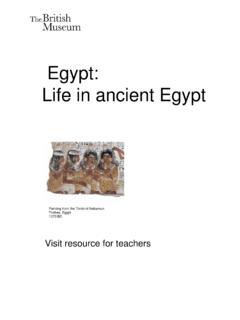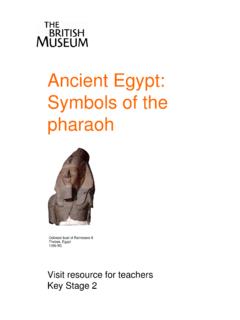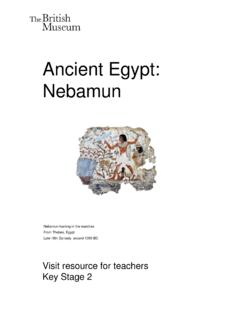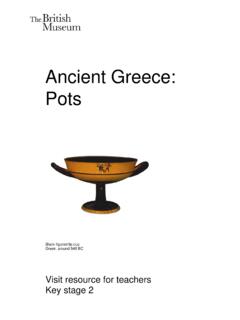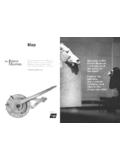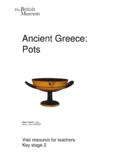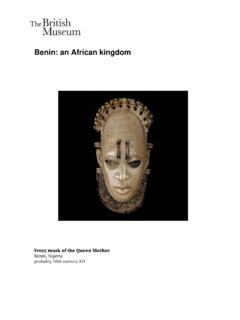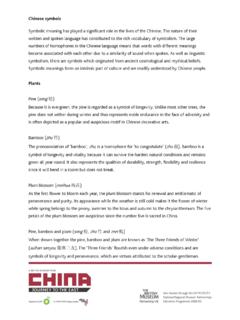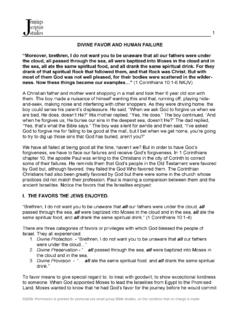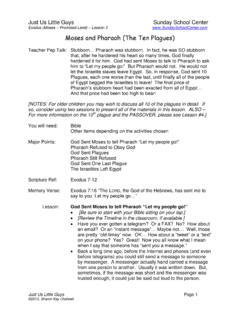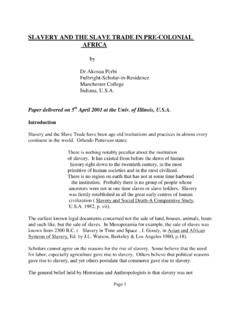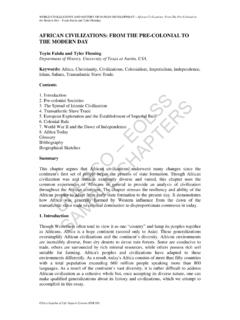Transcription of Egypt: Life in ancient Egypt - British Museum
1 Egypt : life in ancient Egypt Visit resource for teachers Painting from the Tomb of Nebamun Thebes, Egypt 1370 BC ancient Egypt : life in ancient Egypt Contents Before your visit Background information Resources Gallery information Preliminary activities During your visit Gallery activities: introduction for teachers Gallery activities: briefings for adult helpers Gallery activity: Containers Gallery activity: Everyday objects Gallery activity: Gods and goddesses Gallery activity: Good luck amulets Gallery activity: Personal adornment After your visit Follow-up activities ancient Egypt : life in ancient Egypt Before your visit ancient Egypt : life in ancient Egypt Before your visit Background information By 6000 BC people had settled in the Nile Valley.
2 The ancient Egyptian civilisation as we refer to it began in approximately 3000 BC when political control of the Nile Valley was unified under King Narmer. This civilisation lasted until 30 BC when the Romans conquered Egypt and subsequently it became part of the Roman Empire. ancient Egyptian life was shaped by the natural environment, especially the River Nile which was vital to the survival of the ancient Egyptians. The Nile provided, amongst other things, water for the crops, fish to catch, reeds to make papyrus and mud that could be used to make bricks for building. It was also the main travel route. The land beside the Nile provided fertile soil for farming while the geology of the surrounding desert provided natural mineral resources. The ability to read and write was not common amongst the majority of the population.
3 Those who received an education and learnt these skills were amongst the ruling elite or government scribes. ancient Egyptians entertained themselves in a variety of ways. They enjoyed listening to and playing music on instruments such as the harp or lyre. Children had different toys including balls and model animals. Board games such as Senet were popular. The Nile was also a source of much entertainment. People took trips in boats, fished, swam and even hunted crocodiles and hippopotamuses. Wealthier Egyptians enjoyed holding lavish parties with entertainment, food and drink. The Egyptian climate consisted of hot summers and milder winters in the south whilst in the north there was a rainy, humid season in the spring. This is reflected in the clothing worn - robes normally made out of linen. These linen garments could be embellished with beads, fringes or pleats.
4 ancient Egypt : life in ancient Egypt Before your visit Wigs were worn by men or women and were often made from sheep s wool or human hair. They served a decorative function but may also have helped to protect the wearer s head from the sun. Jewellery was worn by both men and women and varied in material and design. Examples range from simple bead necklaces to elaborate gold head-pieces. Jewellery was often symbolic and items such as amulets were worn as good luck charms. ancient Egyptian objects found at archaeological sites are useful because they provide archaeologists with information about both physical actions and thought processes. Through the study of objects deductions can be made about the tools and techniques used to produce it, as well as the nature of its use. The study of ancient Egypt is also supported by writing and pictures.
5 The ancient Egyptians used a pictorial writing system known as hieroglyphs. These have been found carved and written on many different surfaces including papyrus, stone, brick, wood, plaster and metal. Writing can refer to ceremonial beliefs, such as in the Book of the Dead which was placed in tombs, or everyday life , for example a list of items sold by a merchant, a legal document or a letter between friends. The Egyptians also had a large number of pieces of recorded literature including tales, poems and hymns. ancient Egypt : life in ancient Egypt Before your visit Resources British Museum websites Teaching history with 100 objects Free online resources to support teachers working in the new history curriculum through object-based learning. Access information, images, and video as well as teaching ideas for lessons at Key Stages 1-3.
6 Books For adults Hart, George. Egyptian Myths, British Museum Press, 1990. Spencer, A. J. (ed.), The British Museum Book of ancient Egypt , British Museum Press, 2007. For children Hart, George. The British Museum Pocket Dictionary of ancient Egyptian Gods and Goddesses, British Museum Press, 2001 Morris, Neil. Everyday life in ancient Egypt , British Museum Press, 2003. Pemberton, D. and Harris, G. The British Museum Illustrated Encyclopaedia of ancient Egypt , British Museum Press, 2005. Strudwick, Helen. Pocket Timeline of ancient Egypt , British Museum Press, 2005. ancient Egypt : life in ancient Egypt Before your visit Gallery information Rooms 62 and 63 contain objects connected with funerary practice in ancient Egypt including mummies, coffins and other tomb artefacts. The galleries also show the use of modern technology for investigating mummies, with x-ray and CAT-scan images of some of the exhibits.
7 Room 64 covers the development of early Egypt from the prehistoric Stone Age up to 3000 BC. It contains objects which reflect the change from a hunter-gatherer society to the beginnings of dynastic rule. Objects on display include pottery, stone tools, stone palettes and basketwork. The gallery contains an early natural sand-dried mummy and examples of early coffin burials. What is it like to visit these galleries? All three galleries form part of the ancient Egyptian suite of galleries on the Upper Floor of the Museum . Rooms 62 and 63 tend to get very crowded while Room 64 is often quieter. All three galleries have doorways at both ends and the central pathway through the galleries serves as the main route from room to room. Room 63 has an additional two doors making it a cross-roads gallery with a lot of movement at the centre.
8 You will tend to find that areas near the side wall cases are quieter even in a busy gallery. Case Numbers Please note that case numbers are usually small, white and high up on the glass. ancient Egypt : life in ancient Egypt Before your visit General introductory activities Discuss the concept of everyday life and the themes it covers such as food and drink, clothing, housing and religious beliefs. Discuss the effect of climate on everyday life . Compare the climate of modern Egypt and Britain. How does this effect everyday life in terms of things such as food, clothes, housing etc? Activities to support gallery activities Make a collection of everyday utensils. What are the utensils used for? How do they help people perform everyday tasks? ( food preparation, cleaning, communicating, keeping warm.)
9 Discuss what natural and processed materials were available to the ancient Egyptians. What were they used for? What sort of personal adornment do people wear nowadays? Look for examples in shopping catalogues. Why do people wear jewellery? Discuss what lucky charms we use nowadays. ancient Egypt : life in ancient Egypt During your visit ancient Egypt : life in ancient Egypt During your visit Gallery activities: introduction for teachers The gallery activities are a set of activity sheets which can be used by students working in Rooms 62, 63 and 64. The sheets can be used as stand-alone activities or you may wish to develop work around particular sheets as suggested in the before and after sections of this resource. Where case numbers are indicated on a sheet, these are usually to be found marked in white numbers high up on the glass of that particular case.
10 You are welcome to select the activities which are most appropriate for the focus of your visit and adapt sheets to meet the needs of your students. Each activity is designed to support the students in looking at, and thinking about, objects on display in the gallery. Individual activity sheets may be undertaken by single students, in pairs or as a small group. Where space is provided for recording this may be undertaken by the student or an adult helper as is most appropriate for the students involved. Familiarise the students and accompanying adults with the chosen activity sheets at school before the day of the visit. Make sure students and adults know what they are to do and are familiar with the vocabulary used on the sheets or which they may encounter in the gallery. ancient Egypt : life in ancient Egypt During your visit Gallery activities: briefings for adult helpers Gallery activity: Containers Containers can tell us what was stored and used.

